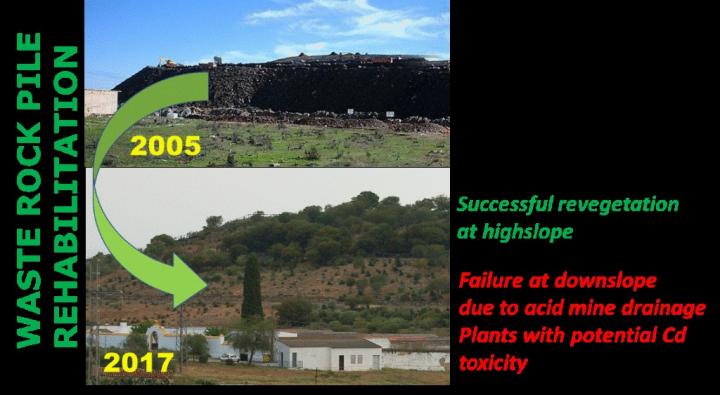
Credit: Universidad de Sevilla
The Cabeza de los Gatos waste rock pile, left from mining activities in the town of Tharsis (Huelva), underwent a rehabilitation process consisting of remodelling the slope of the pile, applying liming materials and then a layer of soil. Finally, trees and shrubs typical of the area were planted and a hydroseeding with a mixture of shrub and herbaceous seeds was applied. Twelve years later, a study led by researchers from IRNAS-CSIC, in collaboration with Sabina Rossini Oliva, a researcher from the University of Seville and the Environment and Water Agency of Andalusia (AMAYA), has proven the effectiveness of this sort of rehabilitation.
“The results obtained show that the steps taken were successful. Now, twelve years later, woody vegetation covers the upper part of the rehabilitated area and provides a green visual landscape for the inhabitants of the village. Furthermore, it has been proved that the aerial part of the vegetation growing on this upper part does not present significant levels of potentially toxic trace elements,” Rossini explained.
In contrast, experts point out that the lower part of the slope is almost devoid of vegetation. Moreover, some of the plants growing at the base of the slope, such as gum rockrose (Cistus ladanifer), have cadmium concentrations exceeding the maximum tolerable level for animals, meaning they represent a toxicity risk for livestock.
“Our view is that this anomaly stems from acidic drainage from the pile which has caused a sharp drop in soil pH at the bottom of the slope. This has increased the presence of potentially toxic trace elements and thus their accumulation in plant leaves. This adverse effect has manifested as lower vegetation cover,” the University of Seville researcher added.
In light of the results obtained, an alternative technique is proposed for the rehabilitation of mine rock waste piles by classifying and selectively managing the mine waste. This technique consists of managing excavation waste and selecting it based on its geochemical properties; separating materials that may generate acid from those that do not. The non-acid-generating waste should then be placed on the outside of the waste rock pile as a protective layer to prevent water contamination. This reduces infiltration rates, seepage and the negative effect of acid drainage from the mine.
###
Media Contact
Sabina Rossini Oliva
[email protected]
Related Journal Article
http://dx.




